住宅设计原则英文
- 格式:doc
- 大小:68.50 KB
- 文档页数:1
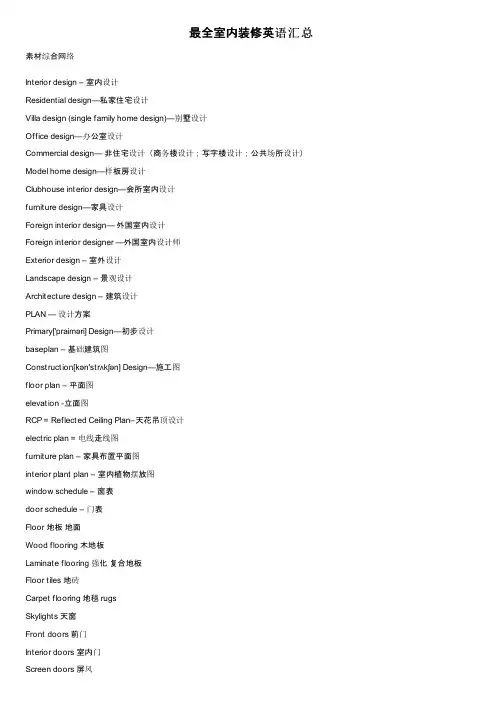
最全室内装修英语汇总素材综合网络Interior design – 室内设计Residential design—私家住宅设计Villa design (single family home design)—别墅设计Office design—办公室设计Commercial design— 非住宅设计(商务楼设计;写字楼设计;公共场所设计)Model home design—样板房设计Clubhouse interior design—会所室内设计furniture design—家具设计Foreign interior design— 外国室内设计Foreign interior designer —外国室内设计师Exterior design – 室外设计Landscape design – 景观设计Architecture design – 建筑设计PLAN — 设计方案Primary['praiməri] Design—初步设计baseplan – 基础建筑图Construction[kən'strʌkʃən] Design—施工图floor plan – 平面图elevation -立面图RCP = Reflected Ceiling Plan–天花吊顶设计electric plan = 电线走线图furniture plan – 家具布置平面图interior plant plan – 室内植物摆放图window schedule – 窗表door schedule – 门表Floor 地板地面Wood flooring 木地板Laminate flooring 强化复合地板Floor tiles 地砖Carpet flooring 地毯 rugsSkylights 天窗Front doors 前门Interior doors 室内门Screen doors 屏风Knobs 把手Fireplace 壁炉Soft furnishing design / soft decoration design 软装设计Function —功能区Living room 客厅Sitting room 起居室Family room 家庭室Dinning room 餐厅Kitchen 厨房Master bedroom 主卧房Quest bedroom 客卧Children bedroom 儿童房Dressing room 更衣室cloakroom 衣帽间Wash room /Laundry 洗衣房Shower bath 淋浴房Bathroom 卫生间Swimming pool 游泳池Basement 地下室Gym 健身房Wine Cellar 酒窖Home Theater 家庭影院Staircase 楼梯间Projection [prə'dʒekʃən] room 视听室Furniture — 家具(1)家具种类Wood furniture 木家具Frame-type furniture 框式家具Panel-type furniture 板式家具Combination (Unit)furniture 组合家具Solid wood furniture 实木家具Bend furniture 弯曲木家具Folding furniture 折叠家具Bedroom suite 卧房家具Drawing room suite 客厅家具Dining room suite 餐厅家具Kitchen furniture 厨房家具Hotel furniture 宾馆家具Modern panel furniture in knock-down 现代板式拆装家具(2)柜类大衣柜(橱)Wardrobe双门衣柜wardrobe2-door组合衣柜Combination wordrobe橱柜Cabinet五斗柜(橱)Chest of drawers床头柜 Bedstand / Bedside cabinet书柜 book case玻璃柜 Glass cabinet酒柜 Wine chest放鞋子的抽屉柜 Chest of drawers for shoes食橱 Cupboard餐具柜 Sideboard办公桌、衣柜、镜台 Bureau碗橱 Kitchen cabinet文件柜 Filing cabinet公文柜 Office cabinet柜类家具 Box-type furniture电视柜 TV set五斗矮柜 Chest of drawers(3)床类(Bed )双人床 Double-bed单人床 Single-bed双层床 Bunk bed儿童摇床 Child cot婴儿床 Baby crib斗床 Bed with drawers沙发床 Sofa bed床架、卧榻 Bedstead床头 Headboard床高屏 Head of the bed床低屏 Foot of the bed(4)桌类书桌办公桌 Desk课桌 School table双人课桌 Double desk茶几 Tea table咖啡桌 Coffee table边几 Side table墙角桌 Corner table梳妆台 Dressing table折叠桌 Folding table写字台 Writing table打字桌 Typewriter desk (Typing desk)方拉桌 Rectangular ext.table圆拉桌 Circular ext.table多用桌 Multi-use desk绘图桌 Drawing table会议桌 Conference table餐桌 Breakfast(Dining) tableDresser 梳妆台吧台Bar Counter(5)椅类椅子 Chair木扶手(出水)沙发 Wooden arms sofa 全包沙发 Upholstered sofa多用沙发 Multi-purposes sofa扶手椅、单人沙发 Armchair双人沙发 2-seater睡椅、长沙发椅 Couch长沙发(无扶手或靠背) Divan转椅 Rotary(Swivel) chair摇椅 Rocking chair or rockers折椅 Folding chair凳 Bench(Stool)折凳 Folding stool柜台凳 Bar stool梳妆凳 Dressing stool安乐椅 Easy chair软垫沙发椅 Upholstered armchair长靠椅 Settee办公椅 Office chair木制有扶手的高背长椅 Settle椅子(无扶手) Side chair试鞋凳 Shoe fitting stool儿童折椅 Children’s folding chair 坐台 Seat餐椅 Dining chair礼堂椅 Assembly chair宝座 Throne躺椅 Reclining chair长凳床尾榻 Benches(6)箱、架类衣箱 Dress case储藏箱 Storage box床头箱 Headstock书架 Book shelf花架 Flower stand屏风 Screen(Floding screen)活动架 Adjusting shelf餐具架 Buffet毛巾架 Towel rack酒架 Wine rack帽架 Hat rack衣架 Coat rack脸盆架 Wash-stand墙架 Wall shelf文件架 Filing shelf搁物架、挂物架 Rack报纸架 Newspaper rack期刊架 Periodicals rack▲CHERRY BOMBLight — 灯具Droplight 吊灯ceiling light 吸顶灯Wall lamp 壁灯Reading /Table lamp 台灯Floor Lamp 落地灯Reflect[ri'flekt] down light 筒灯voltage track light 射灯Embed light 嵌灯Daylight lamp 日光灯Picture light 镜画灯Track light 轨道灯step / riser light 楼梯踏步灯Fabrics —布艺curtain 窗帘Curtain rods 窗帘杆Blinds 百叶窗Bedding 床品Napkin 餐巾Placemat 餐垫Table runner/ flag 桌旗Pillow 枕头窗帘单项篇【窗帘有关】drape 窗帘、褶皱drapery大窗帘panel 窗帘(片)drapery panels 布帘(片)sheer panels 纱帘(片)traversing panels 平垂的帘(片)tie-back panels 扎起的帘(片)tier 小窗帘floor-length drapes 拖地窗帘blind遮光帘、百叶帘matchstick blinds 竹卷帘Jabot & Swag Curtains 有皱褶花饰及垂幔的窗帘lambrequins 垂帷、垂饰、挂帘Shade 遮阳帘(升降帘)London shade 伦敦式Opera shade 歌剧院式Cloud shade 云朵式Balloon Shades 气球式Roman shade 罗马式Austrian shade 奥地利式Folded roman shade 折叠罗马帘Wiring — 电器设备Washer 洗衣机Refrigeratory 冰箱Air-condition 空调Electric cooker 电饭褒Macrowave oven 微波炉Immersion heater 电热水壶Sound box 音响Electrical outlet 插座Switch 开关sanitary ware —卫浴设备Bathroom fixture 卫生洁具Water faucet 水龙头Washbowl 洗手台[台盆] Closestool 座便器Bathtab 浴缸towel = 毛巾架towel bar 毛巾杆soap dispenser 肥皂盒toilet paper holder 卷筒纸架trash receptacle 废料桶垃圾桶Decoration—装饰品Vases 花瓶Books 书Magazine racks 杂志架Plants 绿植Pots 盆栽Frames 相框Painting 挂画Clocks 表Candles 蜡烛Fragrances 香水Mirrors 镜子Fountains 喷泉觉得有用的话,别忘了给老师一个在看鼓励哦编辑|Fancy。
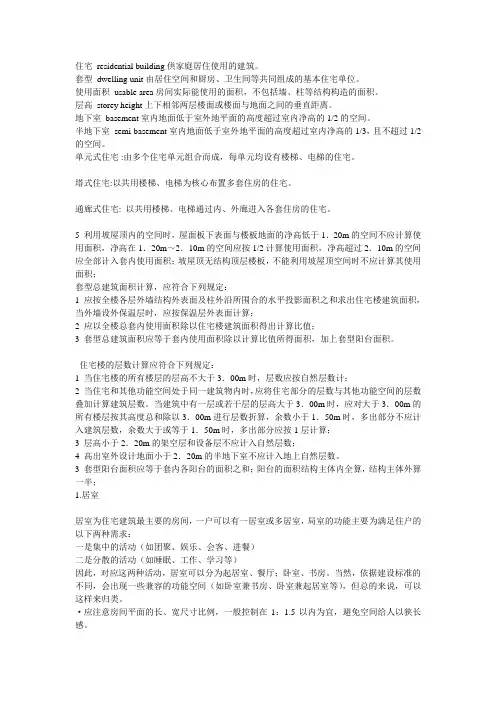
住宅residential building供家庭居住使用的建筑。
套型dwelling unit由居住空间和厨房、卫生间等共同组成的基本住宅单位。
使用面积usable area房间实际能使用的面积,不包括墙、柱等结构构造的面积。
层高storey height上下相邻两层楼面或楼面与地面之间的垂直距离。
地下室basement室内地面低于室外地平面的高度超过室内净高的1/2的空间。
半地下室semi-basement室内地面低于室外地平面的高度超过室内净高的1/3,且不超过1/2的空间。
单元式住宅 :由多个住宅单元组合而成,每单元均设有楼梯、电梯的住宅。
塔式住宅:以共用楼梯、电梯为核心布置多套住房的住宅。
通廊式住宅: 以共用楼梯、电梯通过内、外廊进入各套住房的住宅。
5 利用坡屋顶内的空间时,屋面板下表面与楼板地面的净高低于1.20m的空间不应计算使用面积,净高在1.20m~2.10m的空间应按1/2计算使用面积,净高超过2.10m的空间应全部计入套内使用面积;坡屋顶无结构顶层楼板,不能利用坡屋顶空间时不应计算其使用面积;套型总建筑面积计算,应符合下列规定:1 应按全楼各层外墙结构外表面及柱外沿所围合的水平投影面积之和求出住宅楼建筑面积,当外墙设外保温层时,应按保温层外表面计算;2 应以全楼总套内使用面积除以住宅楼建筑面积得出计算比值;3 套型总建筑面积应等于套内使用面积除以计算比值所得面积,加上套型阳台面积。
住宅楼的层数计算应符合下列规定:1 当住宅楼的所有楼层的层高不大于3.00m时,层数应按自然层数计;2 当住宅和其他功能空间处于同一建筑物内时,应将住宅部分的层数与其他功能空间的层数叠加计算建筑层数。
当建筑中有一层或若干层的层高大于3.00m时,应对大于3.00m的所有楼层按其高度总和除以3.00m进行层数折算,余数小于1.50m时,多出部分不应计入建筑层数,余数大于或等于1.50m时,多出部分应按1层计算;3 层高小于2.20m的架空层和设备层不应计入自然层数;4 高出室外设计地面小于2.20m的半地下室不应计入地上自然层数。
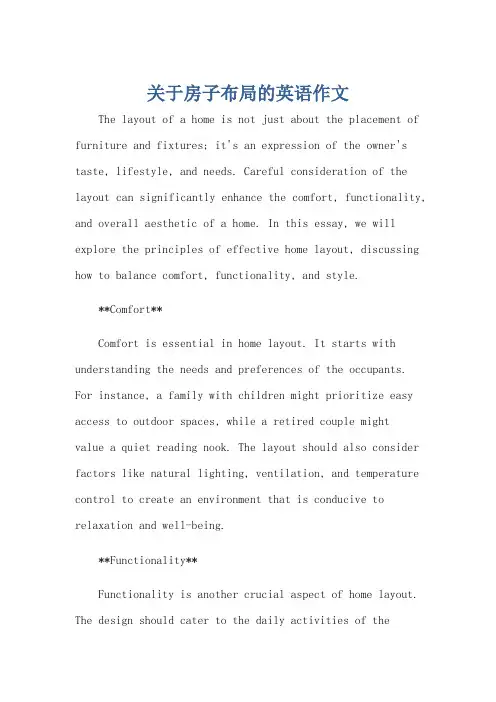
关于房子布局的英语作文The layout of a home is not just about the placement of furniture and fixtures; it's an expression of the owner's taste, lifestyle, and needs. Careful consideration of the layout can significantly enhance the comfort, functionality, and overall aesthetic of a home. In this essay, we will explore the principles of effective home layout, discussing how to balance comfort, functionality, and style.**Comfort**Comfort is essential in home layout. It starts with understanding the needs and preferences of the occupants. For instance, a family with children might prioritize easy access to outdoor spaces, while a retired couple mightvalue a quiet reading nook. The layout should also consider factors like natural lighting, ventilation, and temperature control to create an environment that is conducive to relaxation and well-being.**Functionality**Functionality is another crucial aspect of home layout. The design should cater to the daily activities of theoccupants, making it easy to move around and perform tasks. For instance, the kitchen should be designed for efficient cooking and storage, with counters and appliances placed within easy reach. Similarly, the living room should accommodate gatherings and娱乐 activities, with seating and tables arranged for optimal interaction.**Style**Style is about creating a visually appealing space that reflects the owner's personality and taste. It can be influenced by various factors, including the architecture of the house, the color scheme, and the choice of furniture and fixtures. A modern home might feature clean lines, minimal decoration, and bold colors, while a traditional home might embrace warmer tones and intricate details.**Balancing the Three Aspects**The challenge lies in balancing these three aspects to create a harmonious and inviting home. Comfort, functionality, and style should not be treated as separate entities; they should work together to enhance the overall experience of living in the space. For instance, a comfortable living room might feature cozy seating andample lighting, but if it lacks storage space or isvisually cluttered, it might not be as enjoyable. Similarly, a stylish kitchen might boast sleek appliances and high-end finishes, but if it's not ergonomic or lacks ventilation,it might not be as functional.**Conclusion**In conclusion, the layout of a home is a综合性 taskthat requires careful consideration of comfort, functionality, and style. It's about creating a space that not only looks good but also feels good and serves theneeds of the occupants. By balancing these three aspects,we can create homes that are not just beautiful but also functional and inviting.**家居布局的艺术:舒适、功能与风格的平衡**家居布局不仅仅是家具和装置的摆放,它更是屋主品味、生活方式和需求的体现。
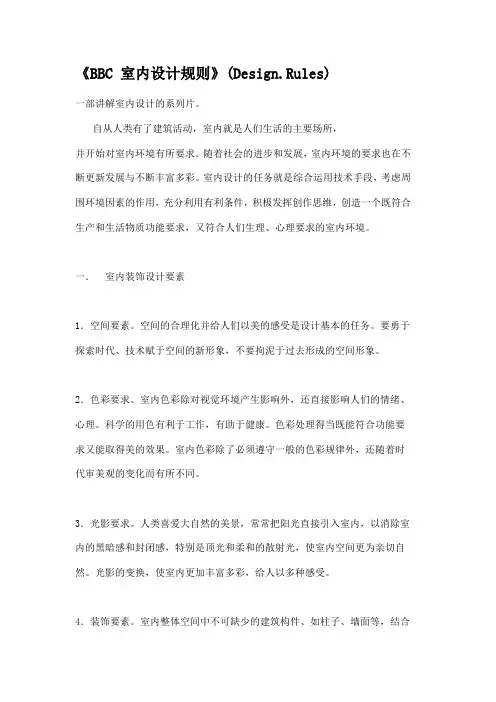
《BBC 室内设计规则》(Design.Rules)一部讲解室内设计的系列片。
自从人类有了建筑活动,室内就是人们生活的主要场所,并开始对室内环境有所要求。
随着社会的进步和发展,室内环境的要求也在不断更新发展与不断丰富多彩。
室内设计的任务就是综合运用技术手段,考虑周围环境因素的作用,充分利用有利条件,积极发挥创作思维,创造一个既符合生产和生活物质功能要求,又符合人们生理、心理要求的室内环境。
一.室内装饰设计要素1.空间要素。
空间的合理化并给人们以美的感受是设计基本的任务。
要勇于探索时代、技术赋于空间的新形象,不要拘泥于过去形成的空间形象。
2.色彩要求。
室内色彩除对视觉环境产生影响外,还直接影响人们的情绪、心理。
科学的用色有利于工作,有助于健康。
色彩处理得当既能符合功能要求又能取得美的效果。
室内色彩除了必须遵守一般的色彩规律外,还随着时代审美观的变化而有所不同。
3.光影要求。
人类喜爱大自然的美景,常常把阳光直接引入室内,以消除室内的黑暗感和封闭感,特别是顶光和柔和的散射光,使室内空间更为亲切自然。
光影的变换,使室内更加丰富多彩,给人以多种感受。
4.装饰要素。
室内整体空间中不可缺少的建筑构件、如柱子、墙面等,结合功能需要加以装饰,可共同构成完美的室内环境。
充分利用不同装饰材料的质地特征,可以获得千变完化和不同风格的室内艺术效果,同时还能体现地区的历史文化特征。
5.陈设要素。
室内家具、地毯、窗帘等,均为生活必需品,其造型往往具有陈设特征,大多数起着装饰作用。
实用和装饰二者应互相协调,求的功能和形式统一而有变化,使室内空间舒适得体,富有个性。
6.绿化要素。
室内设计中绿化以成为改善室内环境的重要手段。
室内移花栽木,利用绿化和小品以沟通室内外环境、扩大室内空间感及美化空间均起着积极作用。
二.室内装饰设计的基本原则1.室内装饰设计要满足使用功能要求室内设计是以创造良好的室内空间环境为宗旨,把满足人们在室内进行生产、生活、工作、休息的要求置于首位,所以在室内设计时要充分考虑使用功能要求,使室内环境合理化、舒适化、科学化;要考虑人们的活动规律处理好空间关系,空间尺寸,空间比例;合理配置陈设与家具,妥善解决室内通风,采光与照明,注意室内色调的总体效果。
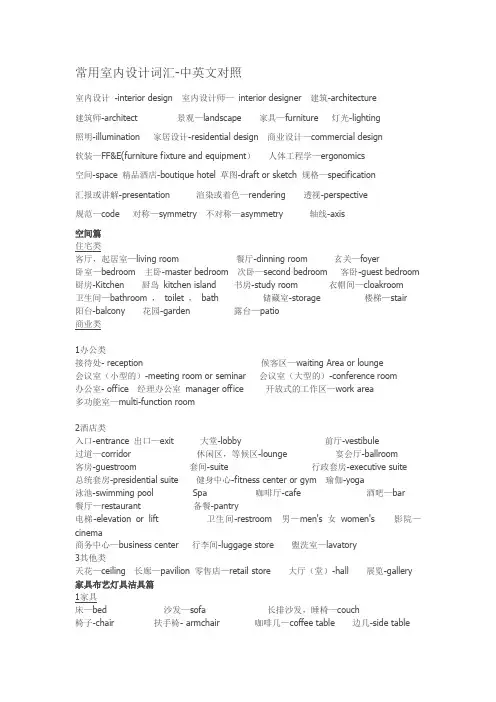
常用室内设计词汇-中英文对照室内设计-interior design 室内设计师—interior designer 建筑-architecture建筑师-architect 景观—landscape 家具—furniture 灯光-lighting照明-illumination 家居设计-residential design 商业设计—commercial design软装—FF&E(furniture fixture and equipment)人体工程学—ergonomics空间-space 精品酒店-boutique hotel 草图-draft or sketch 规格—specification汇报或讲解-presentation 渲染或着色—rendering 透视-perspective规范—code 对称—symmetry 不对称—asymmetry 轴线-axis空间篇住宅类客厅,起居室—living room 餐厅-dinning room 玄关—foyer卧室—bedroom 主卧-master bedroom 次卧—second bedroom 客卧-guest bedroom 厨房-Kitchen 厨岛kitchen island 书房-study room 衣帽间—cloakroom卫生间—bathroom ,toilet ,bath 储藏室-storage 楼梯—stair阳台-balcony 花园-garden 露台—patio商业类1办公类接待处- reception 候客区—waiting Area or lounge会议室(小型的)-meeting room or seminar 会议室(大型的)-conference room办公室- office 经理办公室manager office 开放式的工作区—work area多功能室—multi-function room2酒店类入口-entrance 出口—exit 大堂-lobby 前厅-vestibule过道—corridor 休闲区,等候区-lounge 宴会厅-ballroom客房-guestroom 套间-suite 行政套房-executive suite总统套房-presidential suite 健身中心-fitness center or gym 瑜伽-yoga泳池-swimming pool Spa 咖啡厅-cafe 酒吧—bar餐厅—restaurant 备餐-pantry电梯-elevation or lift 卫生间-restroom 男—men's 女women's 影院—cinema商务中心—business center 行李间-luggage store 盥洗室—lavatory3其他类天花—ceiling 长廊—pavilion 零售店—retail store 大厅(堂)-hall 展览-gallery 家具布艺灯具洁具篇1家具床—bed 沙发—sofa 长排沙发,睡椅—couch椅子-chair 扶手椅- armchair 咖啡几—coffee table 边几-side table角几—end table 脚凳—footrest 吧台凳-stool 书桌—desk餐桌—dinning table 梳妆台—vanity table 柜子-cabinet 衣柜—wardrobe 镜子-mirror 壁炉—fireplace 书架-bookshelf2布艺饰品布衣—fabric 织物—textile 枕头-pillow 靠垫—cushion窗帘—curtain 帐幔—drapery 地毯—carpet 小毯,垫子—mat垫衬-upholstery 壁纸-wallpaper 烛台—candlestick 油画-painting3灯具枝形吊灯—chandelier 吊灯-pendent lighting 灯-lamp 落地灯-floor lamp壁灯-wall sconce 嵌入式灯筒灯-recessed lighting 洗墙灯-wall wash荧光灯-fluorescent lighting 白炽灯—incandescent lighting (lamp) 格栅灯-grille lamp轨道射灯—track lighting 开关—switch4厨房与洁具水盆—sink 水龙头-faucet 冰箱-r efrigerator 抽油烟机-ventilator 烤箱-oven小铁架—racks 马桶-toilet 防溅板—backsplash 小便器—urinal浴盆-tub 喷淋-showerhead 毛巾架-tower bar材料篇石膏-plaster 石头-stone 大理-marble 砖—brick 木地板-wood floor复合地板—laminate floor 枫木—maple 胡桃- walnut 柚木—teak不锈钢—stainless steel 金属-metal 瓷的-ceramic 瓷砖—ceramic tile玻璃—glass 隔音板-acoustic panel施工图及其他篇施工图-working drawing 平面图—floor plan天花图-reflected ceiling plan 缩写RCP 地面铺装图—Floor Finish plan电气图-electrical plan 立面图—elevation剖面图-section 详图(大样图)- detail drawing空调系统—HVAC 比例-scale图表或图例-schedule or legend 尺寸(标注)dimension柱子-column 梁-beam 太阳能的—solar 户外的—outdoor。
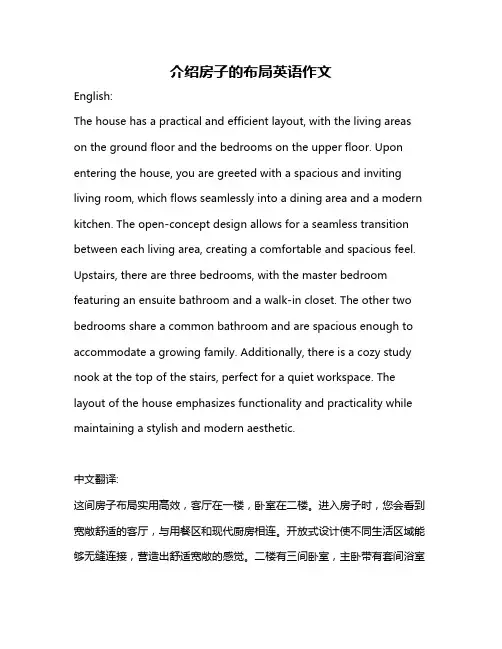
介绍房子的布局英语作文English:The house has a practical and efficient layout, with the living areas on the ground floor and the bedrooms on the upper floor. Upon entering the house, you are greeted with a spacious and inviting living room, which flows seamlessly into a dining area and a modern kitchen. The open-concept design allows for a seamless transition between each living area, creating a comfortable and spacious feel. Upstairs, there are three bedrooms, with the master bedroom featuring an ensuite bathroom and a walk-in closet. The other two bedrooms share a common bathroom and are spacious enough to accommodate a growing family. Additionally, there is a cozy study nook at the top of the stairs, perfect for a quiet workspace. The layout of the house emphasizes functionality and practicality while maintaining a stylish and modern aesthetic.中文翻译:这间房子布局实用高效,客厅在一楼,卧室在二楼。
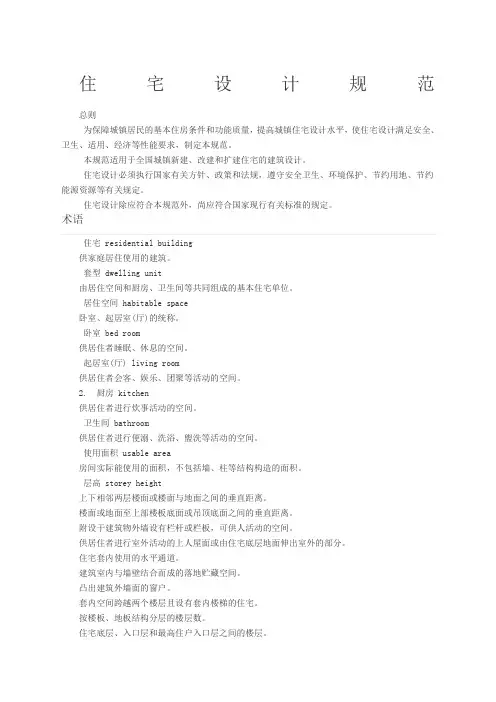
住宅设计规范总则为保障城镇居民的基本住房条件和功能质量,提高城镇住宅设计水平,使住宅设计满足安全、卫生、适用、经济等性能要求,制定本规范。
本规范适用于全国城镇新建、改建和扩建住宅的建筑设计。
住宅设计必须执行国家有关方针、政策和法规,遵守安全卫生、环境保护、节约用地、节约能源资源等有关规定。
住宅设计除应符合本规范外,尚应符合国家现行有关标准的规定。
术语住宅 residential building供家庭居住使用的建筑。
套型 dwelling unit由居住空间和厨房、卫生间等共同组成的基本住宅单位。
居住空间 habitable space卧室、起居室(厅)的统称。
卧室 bed room供居住者睡眠、休息的空间。
起居室(厅) living room供居住者会客、娱乐、团聚等活动的空间。
2. 厨房 kitchen供居住者进行炊事活动的空间。
卫生间 bathroom供居住者进行便溺、洗浴、盥洗等活动的空间。
使用面积 usable area房间实际能使用的面积,不包括墙、柱等结构构造的面积。
层高 storey height上下相邻两层楼面或楼面与地面之间的垂直距离。
楼面或地面至上部楼板底面或吊顶底面之间的垂直距离。
附设于建筑物外墙设有栏杆或栏板,可供人活动的空间。
供居住者进行室外活动的上人屋面或由住宅底层地面伸出室外的部分。
住宅套内使用的水平通道。
建筑室内与墙壁结合而成的落地贮藏空间。
凸出建筑外墙面的窗户。
套内空间跨越两个楼层且设有套内楼梯的住宅。
按楼板、地板结构分层的楼层数。
住宅底层、入口层和最高住户入口层之间的楼层。
仅有结构支撑而无外围护结构的开敞空间层。
住宅套外使用的水平通道。
联系两个相邻住宅单元的楼、电梯间的水平通道。
由多套住宅组成的建筑部分,该部分内的住户可通过共用楼梯和安全出口进行疏散。
室内地面低于室外地平面的高度超过室内净高的1/2的空间。
室内地面低于室外地平面的高度超过室内净高的1/3,且不超过1/2的空间。
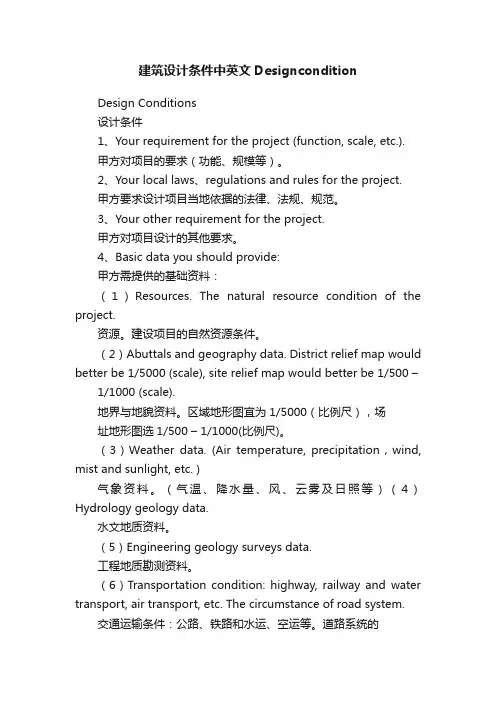
建筑设计条件中英文DesignconditionDesign Conditions设计条件1、Your requirement for the project (function, scale, etc.).甲方对项目的要求(功能、规模等)。
2、Your local laws、regulations and rules for the project.甲方要求设计项目当地依据的法律、法规、规范。
3、Your other requirement for the project.甲方对项目设计的其他要求。
4、Basic data you should provide:甲方需提供的基础资料:(1)Resources. The natural resource condition of the project.资源。
建设项目的自然资源条件。
(2)Abuttals and geography data. District relief map would better be 1/5000 (scale), site relief map would better be 1/500 –1/1000 (scale).地界与地貌资料。
区域地形图宜为1/5000(比例尺),场址地形图选1/500 – 1/1000(比例尺)。
(3)Weather data. (Air temperature, precipitation,wind, mist and sunlight, etc. )气象资料。
(气温、降水量、风、云雾及日照等)(4)Hydrology geology data.水文地质资料。
(5)Engineering geology surveys data.工程地质勘测资料。
(6)Transportation condition: highway, railway and water transport, air transport, etc. The circumstance of road system.交通运输条件:公路、铁路和水运、空运等。
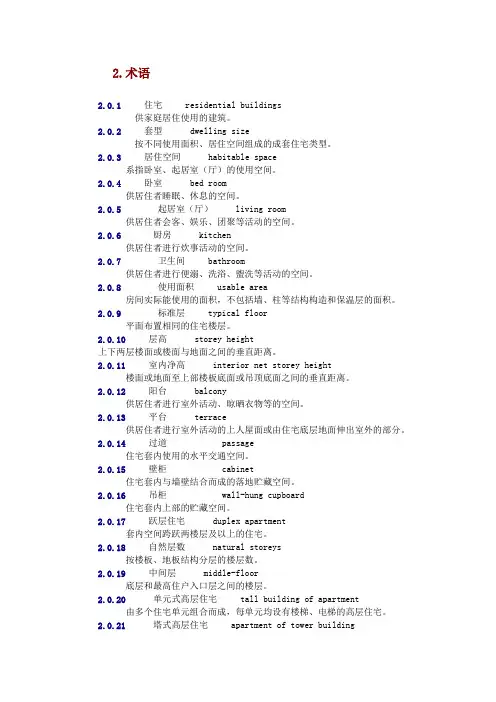
2.术语2.0.1 住宅 residential buildings供家庭居住使用的建筑。
2.0.2 套型 dwelling size按不同使用面积、居住空间组成的成套住宅类型。
2.0.3 居住空间 habitable space系指卧室、起居室(厅)的使用空间。
2.0.4 卧室 bed room供居住者睡眠、休息的空间。
2.0.5起居室(厅) living room供居住者会客、娱乐、团聚等活动的空间。
2.0.6厨房 kitchen供居住者进行炊事活动的空间。
2.0.7卫生间 bathroom供居住者进行便溺、洗浴、盥洗等活动的空间。
2.0.8使用面积 usable area房间实际能使用的面积,不包括墙、柱等结构构造和保温层的面积。
2.0.9标准层 typical floor平面布置相同的住宅楼层。
2.0.10层高 storey height上下两层楼面或楼面与地面之间的垂直距离。
2.0.11室内净高 interior net storey height楼面或地面至上部楼板底面或吊顶底面之间的垂直距离。
2.0.12阳台 balcony供居住者进行室外活动、晾晒衣物等的空间。
2.0.13平台 terrace供居住者进行室外活动的上人屋面或由住宅底层地面伸出室外的部分。
2.0.14过道 passage住宅套内使用的水平交通空间。
2.0.15壁柜 cabinet住宅套内与墙壁结合而成的落地贮藏空间。
2.0.16吊柜 wall-hung cupboard住宅套内上部的贮藏空间。
2.0.17跃层住宅 duplex apartment套内空间跨跃两楼层及以上的住宅。
2.0.18自然层数 natural storeys按楼板、地板结构分层的楼层数。
2.0.19中间层 middle-floor底层和最高住户入口层之间的楼层。
2.0.20单元式高层住宅 tall building of apartment由多个住宅单元组合而成,每单元均设有楼梯、电梯的高层住宅。
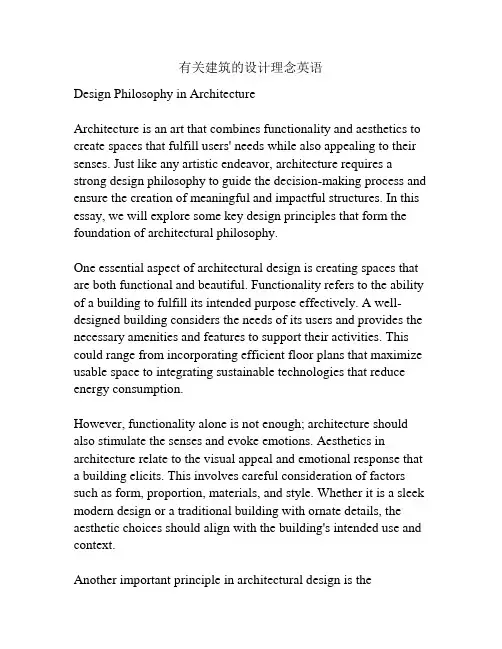
有关建筑的设计理念英语Design Philosophy in ArchitectureArchitecture is an art that combines functionality and aesthetics to create spaces that fulfill users' needs while also appealing to their senses. Just like any artistic endeavor, architecture requires a strong design philosophy to guide the decision-making process and ensure the creation of meaningful and impactful structures. In this essay, we will explore some key design principles that form the foundation of architectural philosophy.One essential aspect of architectural design is creating spaces that are both functional and beautiful. Functionality refers to the ability of a building to fulfill its intended purpose effectively. A well-designed building considers the needs of its users and provides the necessary amenities and features to support their activities. This could range from incorporating efficient floor plans that maximize usable space to integrating sustainable technologies that reduce energy consumption.However, functionality alone is not enough; architecture should also stimulate the senses and evoke emotions. Aesthetics in architecture relate to the visual appeal and emotional response that a building elicits. This involves careful consideration of factors such as form, proportion, materials, and style. Whether it is a sleek modern design or a traditional building with ornate details, the aesthetic choices should align with the building's intended use and context.Another important principle in architectural design is theincorporation of sustainable and environmentally friendly practices. With the growing concerns about climate change and diminishing resources, architects have a responsibility to design buildings that minimize their ecological footprint. This can be achieved through strategies like passive design, where the building is oriented to optimize natural light and airflow, thus reducing the need for artificial lighting and cooling. The use of renewable energy sources, rainwater harvesting systems, and green roofs are also examples of sustainable practices that can be integrated into architectural design.Additionally, buildings should respond to their context and enhance the surrounding environment. Architecture is not an isolated entity but rather a part of the fabric of the built environment. Therefore, it is crucial to consider factors such as the site's history, culture, and natural landscape when designing a structure. An architecture that seamlessly integrates with its surroundings can create a harmonious and cohesive environment that enhances the well-being of its occupants and brings a sense of belonging to the community.Furthermore, architecture should prioritize the well-being and comfort of its users. People spend the majority of their time indoors, and buildings can significantly impact their physical and mental health. Designing spaces that promote natural light, good air quality, and acoustics can enhance productivity, creativity, and overall well-being. Additionally, incorporating green spaces and communal areas fosters social interaction and a sense of community among the building's occupants.In conclusion, a strong design philosophy is essential forsuccessful architectural design. Functionality, aesthetics, sustainability, contextual responsiveness, and user well-being are all crucial principles that guide architects in creating meaningful and impactful buildings. By incorporating these principles, architects can shape the built environment in a way that not only fulfills the practical needs of users but also inspires and improves their quality of life.。
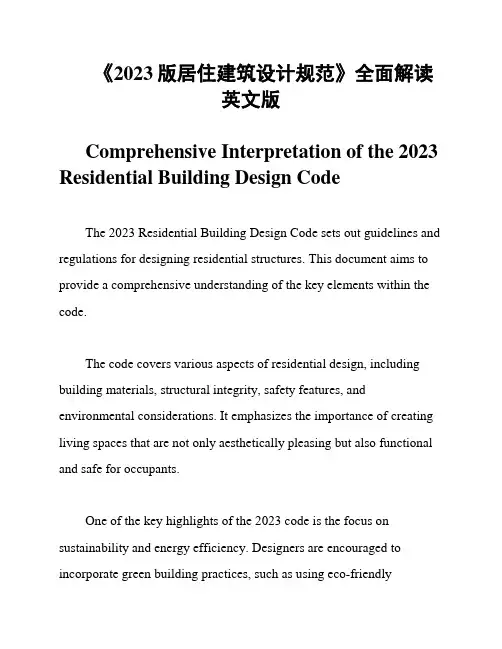
《2023版居住建筑设计规范》全面解读英文版Comprehensive Interpretation of the 2023 Residential Building Design CodeThe 2023 Residential Building Design Code sets out guidelines and regulations for designing residential structures. This document aims to provide a comprehensive understanding of the key elements within the code.The code covers various aspects of residential design, including building materials, structural integrity, safety features, and environmental considerations. It emphasizes the importance of creating living spaces that are not only aesthetically pleasing but also functional and safe for occupants.One of the key highlights of the 2023 code is the focus on sustainability and energy efficiency. Designers are encouraged to incorporate green building practices, such as using eco-friendlymaterials and reducing energy consumption through proper insulation and ventilation.Additionally, the code outlines specific requirements for different types of residential buildings, such as single-family homes, multi-family complexes, and high-rise apartments. It provides detailed guidelines for each category, ensuring that all structures meet the necessary standards for safety and livability.Overall, the 2023 Residential Building Design Code aims to promote high-quality, sustainable residential construction practices that prioritize the well-being of occupants and the environment. By adhering to these guidelines, designers can create homes that are not only visually appealing but also efficient, safe, and environmentally friendly.。
(注:多年前一朋友将此文件传给我,据说是有关部门用于国际招标文件的材料。
我未考证。
如果此文是出自未知名某位作者,请指正。
我将立刻删除或链接原始出处。
之所以放于此,是供需要者参考。
该英文比较地道。
)第一节总平面Chapter1: Site Planning一、在方案设计阶段,总平面专业设计文件应包括:I. During the conceptual design period, the overall design documents should include:1. 设计说明书;1. Design Description;2. 设计图纸。
2. Drawings.二、设计说明书II. Design Description应对总体方案构思意图作详尽的文字阐述,并应列出技术经济指标表(包括总用地面积;总建筑面积;建筑占地面积;各主要建筑物的名称、层数、高度;以及建筑容积;覆盖率;道路广场铺砌面积;绿化面积;绿化率;必要时及有条件情况下计算场地初平土方工程量等)。
Design description should include detailed explanation about the idea of the overall design as well as a list of technical-economic indices (such as site area, total floor area, built-up area, major buildings’ names, levels and height, plot ratio, coverage rate, paving area of roads and plazas, green area, afforestation rate, calculation of land leveling earthwork if necessary and applicable, etc).三、设计图纸III. Drawings.1. 用地范围的区域位置;1. Site Location;2. 用地红线范围(各角点测量座标值、场地现状标高、地形地貌及其它现状情况反映);2. Site Scope Defined by Building Lines (coordinates of angle points, current site level, terrain and landform, etc);3. 用地与周围环境情况反映(如用地外围城市道路;市政工程管线设施;原有建筑物、构筑物;四邻拟建建筑及原有古树名木、历史文化遗址保护等)。
・房屋各部分Parts of house屋面roof屋脊ridge坡屋顶pitched roof单坡屋顶pent roof, lean-to roof 人字屋顶gable roof四坡顶hipped roof屋面排水沟valley卷材防水屋面membrane roof找平层screed-coat防水层damp-proof course 泛水flashing屋顶层garret阁楼penthouse, loft, attic天台roof-deck晒台drying stage组合烟囱chimney stack屋檐eave屋面排水roofing drainage檐沟,明沟gutter水落管down-pipe, downspout 雨棚canopy, awning 柱廊colonnade走廊corridor中庭atrium山墙gable女儿墙parapet山花pediment隅石砌quoins阳台balcony, veranda阳台栏杆balustrade阳台栏杆柱baluster, banister平台terrace台阶steps梯子ladder梯级step楼梯staircase(=step)楼梯踏步平板tread楼梯踏步竖板riser楼梯休息平台landing直角转弯平台quarter-space landing 梯宽run of stair梯高rise of stair楼梯扶手rail, railing回转梯 corkscrew staircase, caracole踏步突沿nosing窗子window百叶窗blinds, louvers 旋转窗balance window平开窗,窗叶casement窗扇sash中旋窗awning window上下推拉窗double-hung window 屋顶通气窗clerestory门窗亮子transom窗木框window frame窗台sill, cill采光顶sunroof天窗sunlight老虎窗dormer-window通风窗ventlight落地窗French window墙壁wall承重墙bearing wall隔间partition空心墙cavity wall防火隔断(分区)compartmentation 剪力墙shear panel墙裙wainscot窗间墙pier幕墙curtain wall电梯elevator, lift自动扶梯escalator地板,楼面 floor夹层楼面entresol, mezzanine 楼座balcony楼板slab天花板ceiling壁炉andiron, fireplace,grate地下室basement防火fire-cut防火门fire door耐热涂料heat-resisting paints绝热heat insulation 门槛head-rail, sill柱子column, post,pillar柱头column cap, head斜撑knee brace悬索catenary梁beam基础梁grade beam钢板梁plate girder工字梁I-beam过梁lintel, lintol, head 椽子purlin基础foundation碎石垫层hard core混凝土地基concrete foundation 基座、柱础pedestal独立基础isolated footing放大基础spreading footing条形基础strip footing筏式基础mat foundation浮筏基础floating foundation 沉箱基础caisson化粪池cesspool, septic tank伸缩缝expansion joint冷桥thermal bridge散水wash, apron披水板weathering-board 桁架truss组合桁架composite truss框架framework模板formwork拱券arch穹顶dome平拱flat arch筒拱vault, vaulted roof 半圆穹顶concha瓦shingle, tile砖brick瓷砖ceramic tile玻璃砖glass blocks大理石marble花岗岩granite水磨石terrazzo砌块masonry混凝土concrete预制混凝土pre- cast concrete钢筋混凝土reinforced concrete 钢筋steel reinforcement 水泥cement抹灰,灰泥plaster, stucco熟石灰 hydrate of lime, slaked-lime 砂浆mortar抹灰层floated coat饰面finish木砖grounds, timber brick 石膏gypsum石膏板plaster slab夹胶玻璃plyglass胶合板plywood, clip-board 脚手架scaffolding悬臂cantilever叠涩,牛腿corbel遮阳sun shading・制图与构图用语草图sketch, draft图纸drawing施工图working drawings工程project、 1 一:一, 方案plan总图grid总平面site平面floorelevation立面正立面facade剖面section详图detail门厅上部upper foyer比例尺scale二透视图,表现图rendering透视perspective轴测isometric perspectiveAxonometric projection轴线axis 建筑面积 floor area, architecture area 相对标高relative elevation/level层高,净空 headroom, headway室内interior室外exterior室内装修interior decoration 装饰ornament广场 square, plaza, public square 流线circulation解构deconstruction空间space, spatial比例proportion统一unity均衡balance协调harmony高层建筑high-rise building 社区housing complex 家舍house 茅舍cottage 平房 one-story house , bungalow ,plain-house二楼 two-story house 公寓(建筑) apartment house公寓(房间) apartment (flat )(英) 别墅villa 花园洋房garden house 寄宿舍 dormitory (美)出租房间room for rent (美) 乡村旅舍 country inn供膳寄宿舍 boardinghouse大厦mansions, edifice 大楼 building预制装配式房屋pre-fabricate house 小木屋尺度韵律风格功能关系・房屋 Housescale rhythm style function relationship 供膳出租房间board and lodgingshack一个单元one unit 车库garage报告厅auditorium, lecture hall多功能厅multi-use hall阅览室 browsing room, reading room茶室refreshment room操作间cab, utility room・居住 Dwelling套房suit主人套房master suit门厅,前厅lobby大厅hall, main hall过厅gallery起居间living RM, family RM 聚会厅 gathering RM, keeping RM休息厅lounge, sitting RM客厅parlor衣帽间cloakroom更衣、衣橱间 walk-in-closet, W.I.C.厨房kitchen餐厅dinning room早餐厅nook, breakfast room食品、餐具间 pantry, butlery浴室,洗手间bathroom盥洗室toilet room卫生间water closet, W.C.前室,门厅foyer寝室,卧房bedroom主人房master bedroom 书斋,书房study, library 工作室,画室studio私室,书斋den化妆室boudoir, dressing RM, powder RM婴儿室nursery客房guestroom壁厨closet, ambry 洗衣间laundry room地窖cellar储藏室storage健身房exercise RM服务入口service entry 换鞋处mud room游艺室games room活动室activities room 音乐室music alcove工人房maid bedroom台球室billiards room 温室greenhouse•家具 Furniture方桌square table圆桌round table长方桌rectangle table伸缩桌小桌凳子有肘的椅子摇椅,安乐椅藤椅塑料椅帆布椅折椅沙发长椅桌子,餐桌玻璃桌子塑料桌子木制饭桌table glass tableacrylic tablewooden-table extension table side tablestool armchair rocking chair rattan chair plastic chair deck chair folding chair sofa couch。
别墅庭院设计理念英文Villa Courtyard Design PhilosophyVilla courtyard design plays a crucial role in determining the overall architectural character of a villa. It not only enhances the aesthetic appeal of the villa but also serves functional purposes such as providing a space for outdoor activities, relaxation, and entertainment. In this article, we will discuss the design philosophy that underpins the creation of villa courtyards.The design philosophy of a villa courtyard revolves around three main aspects, namely form, function, and context. Firstly, the form of the courtyard refers to its shape, proportions, and spatial organization. The form should complement the architecture of the villa and create a harmonious and balanced composition. For instance, the courtyard's shape can either be square, rectangular, or circular, depending on the villa's architectural style. The proportions should also be considered to ensure that the courtyard is aesthetically pleasing and appears well-integrated with the villa's architectural elements.Secondly, function refers to the purpose or activities that the courtyard is intended to serve. It should cater to the lifestyle and needs of the villa's occupants. For instance, the courtyard can be designed as a space for outdoor dining, relaxation, or entertainment. It can also be equipped with features such as apool, water fountain, or fireplace to enhance its functionality and aesthetics. The choice of materials and furniture should also be selected based on the courtyard's functions and the desired ambiance.Lastly, the context refers to the site-specific factors that influence the design of the villa courtyard. The location, climate, topography, and adjacent landscapes all play a crucial role in determining the courtyard's design. For instance, if the villa is located on a sloping site, the courtyard's design should consider the terrain's contours and slopes. Similarly, if the climate is hot and dry, the courtyard should be designed as a shady retreat to escape the heat.In addition to the above aspects, some other essential design considerations include sustainability, durability, and maintenance. The courtyard's design should incorporateenvironmentally-friendly features that promote sustainability, such as drought-tolerant planting, permeable paving, and rainwater harvesting. The materials and construction techniques used should also ensure the durability of the courtyard's features, such as the pool, fountain, and paving. Moreover, a well-designed courtyard should be easy to maintain and require minimal upkeep to retain its aesthetic appeal.To conclude, the design philosophy of villa courtyards focuses on achieving a harmonious balance between form, function, and context. An ideal courtyard design shouldcomplement the villa's architecture, cater to the occupants' lifestyle, and reflect the site-specific factors. With careful consideration of these design principles, a villa courtyard can become a tranquil and beautiful oasis that enhances the villa's overall appeal.。
《2023版现代住宅设计规划》英文版Title: 2023 Edition Modern Residential Design PlanningIn the ever-evolving world of architecture and design, the 2023 Edition Modern Residential Design Planning document aims to set the standards for innovative and functional living spaces. This comprehensive guide addresses the latest trends and technologies in the field, offering a fresh perspective on how to create homes that cater to the needs and desires of modern homeowners.From sustainable building materials to smart home integration, the document explores various aspects of residential design to ensure that each project is not only aesthetically pleasing but also environmentally friendly and technologically advanced. By emphasizing the importance of natural light, open floor plans, and efficient space utilization, the guide provides architects and designers with the tools they need to create homes that are both beautiful and practical.With a focus on simplicity and functionality, the 2023 Edition Modern Residential Design Planning document encourages designers to think outside the box and push the boundaries of traditional design concepts. By combining form and function in innovative ways, architects can create living spaces that are both visually stunning and highly livable.By embracing the principles outlined in this document, architects and designers can revolutionize the way we think about residential design. The 2023 Edition Modern Residential Design Planning sets the stage for a new era of architecture, where creativity and sustainability go hand in hand to create homes that are truly exceptional in every way.。
Design principles of a residence
1、private/public separation
The privacy of a residence includes not only the visual privacy and the acoustical privacy, but also the spatial association.
The bedroom, the working room and the toilet for
residents of the home belong to the private area.
Non-residents of the home should not be forced to
pass through the private area in the course of their
visit.
The dining room, living room and the toilet for
guests belong to the public area. These rooms
should be located to positions that make them
accessible to guests. Having these rooms adjacent to
the entry foyer accomplishes this.
2、noisy/quiet separation
The quiet area includes the bedroom and working
room. The dining room, kitchen and living room,
however, are not as quiet. Separating these two areas
is necessary so that the noise is less likely to
bothersome to those sleeping or working while
activity continues elsewhere in the house. These
requirements may usually be satisfied by the
private/public separation.
3、dirty/clean separation
Kitchen and toilet produce fumes and waste everyday. What’s more, both of them need piping systems. Grouping them together can not only reduce the cost of piping and labor to install it, but also keep the other parts of the house clean. If there are two toilets, it’s better to group them together.
4、physical environment
Sunshine is very important for people’s health, especially the young and the old. Besides, a room receiving the sunshine is much warmer than the one no in winter. So placing the bedroom in the south of a house seems to be a rule in residence design. But in summer, designer should take measures to keep the sun out of the room. For example, using shutters is a good way.
Natural ventilation has much to do with the comfort of people inside the house. Most of the room needs windows so that the natural blasts can bring the fresh air in. Windows also allow the natural light into the rooms.
All the measures above can make the house better to health and comfort of the people inside. In addition, they can help the electrical energy saving.。